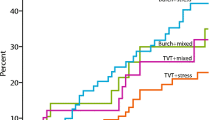Abstract
This paper includes the preoperative, early (i.e. half a year) and late postoperative (on average 3.8 years) clinical, urodynamic and morphological findings of 145 stress incontinent women. An anterior vaginal repair was performed in 54 patients, while 91 received urethrovaginal fixation according to Burch. Early postoperative analysis of urodynamic parameters shows deterioration in the vaginal repair group and improvement of the colposuspension group. Comparison of early and late postoperative urodynamic findings indicates gradual deterioration as a function of time. Morphological findings prove that the abdominal operation elevated and attached the bladder neck better and more durably to the symphysis pubis, even though late postoperative examinations show impairment of these results with time. Follow-up showed that in the early postoperative period 91% of patients with urethrovaginal fixation were cured or improved, while the success rate for the vaginal repair was 76%; late postoperative results revealed 89% and 86% cure or improvement rates respectively. The results confirm that the success of operative repair is highly dependent on the selection of the correct procedure by proper preoperative diagnostic evaluation.
Similar content being viewed by others
References
Richardson DA, Ostergard DR. Anterior vaginal repair versus retropubic urethropexy: a review of the literature. In: Ostergard DR ed. Gynecologic urology and urodynamics 2nd edn. Baltimore: Williams & Wilkins, 1985; pp. 469–477
Kãser O, Ikle FA, Hirsch A. Atlas der gynãkologischen Operationen, Stuttgart: 4. Auflage Thieme Verlag, 1983; 12.28–12.34
Burch JC. Urethrovaginal fixation to Cooper's ligament for correction of stress incontinence, cystocele and prolapse. Am J Obstet Gynecol 1961; 81:281–290
Gaudenz R. Der Inkontinenz — Fragebogen mit dem neuen Urge-Score und Stress-score. Geburtsh Frauenheilk 1979; 39:784–792
Jonas U, Heidler H, Thüroff J. Urodynamik-Diagnostik der Funktionsstõrungen des unteren Harntraktes. Stuttgart: Enke Verlag, 1980; 15–40, 54–73, 76–78
Ingelman-Sundberg A. Urininkontens hos kvinnan. Norkisk Medicin 1953; 50:1149–1152
Eberhard J, Schãr G. Gynãkologische Urologie. Gynãk Rdsch 1991; 31:(Suppl. 1):1–52
Eberhard J. Standardisierte Urethradruckmessung mit Normwerten zur Streßinkontinenzdiagnostik. Geburtsh Frauenheilk 1986; 46:145–150
Arbeitsgemeinschaft für urologische Gynãkologie: Vorschlãge zur Definition und Standardisierung in der Urodynamik. Arch Gynecol 1985; 238:25–33
International Continence Society First report on the standardization of terminology of lower tract urinary function. Br J Urol 1976;48:39–42
Green TH Jr. Urinary stress incontinence: differential diagnosis, pathophysiology and management. Am J Obstet Gynecol 1975; 122:368–400
Kranzfelder D, Baumann-Müller A, Kristen P. Das Rezidiv nach Harninkontinenzoperationen. Geburtsh Frauenheilk 1990; 7:552–559
Peters FD, Roemer VM, Briel RC, Gassner K. Urodynamische Befunde bei Frauen nach Harninkontinenzoperationen. 1: Mitteilung: Vordere Kolporrhapie. Geburtsh Frauenheilk 1980; 40:619–623
Stõcklin MW, Alder CG. Subjektive und objektive Verbesserung der weiblichen Harninkontinenz nach vaginalen und abdominalen Inkontinenzoperationen. Geburtsh Frauenheilk 1986; 46:524–529
Vahlensieck WKG, Schander K. Langzeitergebnisse der operativen Behandlung der Streßinontinenz durch vordere Kolporrhaphie mit Diaphragmaplastik. Geburtsh Frauenheilk 1985; 45:887–890
Voigt R, Kunath H. Urodynamische Resultate vor und nach operativer Behandlung der Streßinkontinenz der Frau. Z Urol Nephrol 1985; 78:357–361
Briel RC. Follow-up of a new modification of the Marshall-Marchetti-Krantz(MMK)procedure. Arch Gynecol 1986; 239:1–9
Peters FD, Roemer VM. Urodynamic findings following surgery in women with urinary stress incontinence. 3. Communication: a modified Marshall-Marchetti-Krantz procedure. Arch Gynecol 1981; 230:299–306
Rydstrõm H, Josif CS. Urodynamic studies before and after retropubic colpourethropexy in fertile women with stress incontinence. Am J Obstet Gynecol 1983; 147:325–327
Weil A, Reyes H, Bischoff P, Rottenberg RD, Krauer F. Modifications of the urethral rest and stress profiles after different types of surgery for urinary incontinence. Br J Obstet Gynecol 1984; 91:46–55
Petri E. Urodynamische Untersuchungen in der Gynãkologie. Gynãkologe 1988; 21:185–187
Grüneberger A, Geier G. Welchen Stellenwert hat der maximale Urethraverschlußdruck für die Beurteilung der Erfolgschance von Streßinkontinenzoperationen? Geburtsh Frauenheilk 1981; 41:465–468
Hetzenhauer A, Manzl J, Reider W, Marth C. Urodynamische Parameter vor und nach vaginaler Inkontinenzoperation. Geburtsh Frauenheilk 1986; 46:27–29
Schwenzer T, Schwenzer C, Schwenzer M. Definition und ãtiologische Faktoren der hypotonen Urethra in Verbindung mit der Streßinkontinenz der Frau. Geburtsh Frauenheilk 1989; 46:857–864
Õbrink A, Bunne G. Urethral pressure profile at pubococcygeal repair for stress incontinence. Acta Obstet Gynecol Scand 1980; 59:433–437
Rud T, Andersson KE, Asmussen M, et al. Factors maintaining the intraurethral pressure in women. Invest Urol 1980; 17:343–347
Ulmsten U. Physiologie der Kontinenz und Pathophysiologie der Streßinkontinenz. Gynãk Rdsch 1985; 25(Suppl. 3):1–14
Henrikson L, Ulmsten U. A urodynamic evaluation of the effects of abdominal urethropexy and vaginal sling urethroplasty in women with stress incontinence. Am J Obstet Gynecol 1978;131:77–82
Peters FD, Roemer VM. Urodynamische Befunde bei Frauen nach Harninkontinezoperationen. 4. Mitteilung: Das Rezidiv-Risiko. Geburtsh Frauenheilk 1981; 41:15–19
Bowen LW, Sand PK, Ostergard DR, Franti CE. Unsuccessful Burch retropubic urethropexy: a case-controlled urodynamic study. Am J Obstet Gynecol 1989; 160:452–458
Kremling H. Zur rezidivierenden Belastungs (Streß)-Inkontinenz. Geburtsh Frauenheilk 1985; 45:634–640
Author information
Authors and Affiliations
Rights and permissions
About this article
Cite this article
Wichmann, M., Baumann -Müller, A. & Kranzfelder, D. Surgical therapy for urinary incontinence: a prospective urodynamic and radiologic long-term study. Int Urogynecol J 5, 255–263 (1994). https://doi.org/10.1007/BF00376234
Issue Date:
DOI: https://doi.org/10.1007/BF00376234




